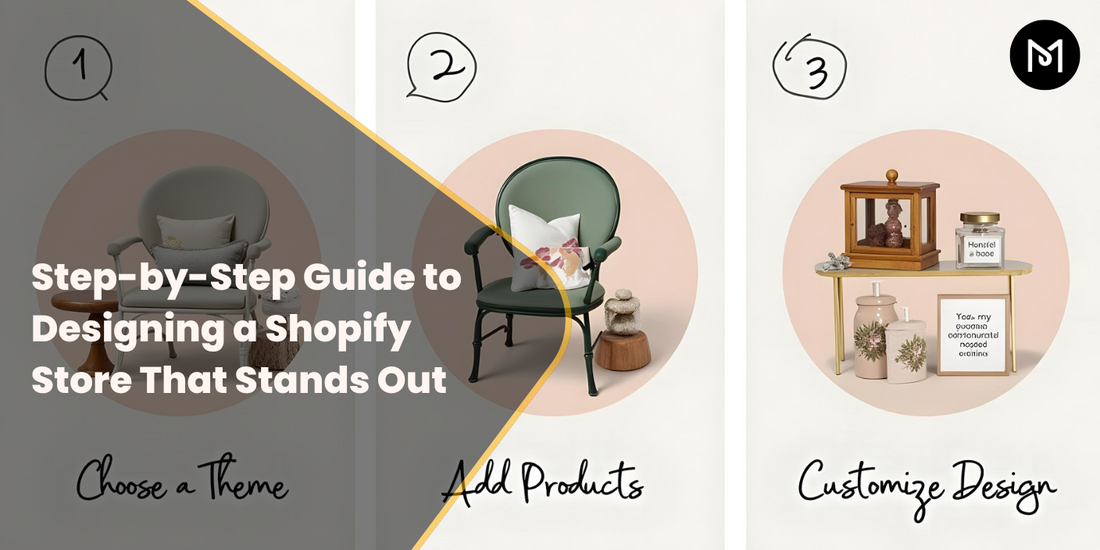Table of contents
- 1. Choose the Right Shopify Experts
- 2. Create a Strong Brand Identity
- 3. Optimize User Experience (UX)
- 4. Mobile Optimization
- 5. Set Up Shopify Payments and Inventory Management
- 6. Marketing Automation for Shopify
- 7. Enhance the Shopping Experience with Custom Features
- 8. Focus on Secure Website Development
- 9. Make Your Store Scalable
- 10. Track and Analyze Your Store’s Performance
- Conclusion
When it comes to building a Shopify store, the design plays a crucial role in attracting customers, ensuring smooth navigation, and increasing conversions. But how do you design a store that truly stands out from the crowd?
Whether you're starting from scratch or redesigning an existing site, this blog will take you through the key steps to ensure your Shopify store is user-friendly, visually appealing, and ready to boost your sales.
1. Choose the Right Shopify Experts
Before diving into the design process, it's essential to have the right team on your side. Choosing the right Shopify expert agency can make all the difference. Experienced professionals, like those at Shopify Plus Partners, can offer specialized guidance, especially for larger stores or advanced Shopify Plus migrations.
An expert Shopify agency will help with everything from setting up your store to creating custom designs personalized to your brand. If you're migrating from another platform, like Prestashop to Shopify, look for Shopify migration experts who can smoothly handle the transition.
Pro Tip:
If you’re unsure, check the Shopify expert portfolio to see their past work and ensure they align with your vision.

2. Create a Strong Brand Identity
Your Shopify store should be an extension of your brand, so it’s important to create a strong visual identity. This includes choosing the right color scheme, fonts, and layout. Whether you’re working with a Shopify web designer or handling the design yourself, make sure the design reflects your brand’s personality.
Shopify Store Design Tips
-
Keep the design simple and clean, with easy-to-read fonts and eye-catching colors that match your logo and overall theme.
-
Ensure that your Shopify website design stays consistent across all pages and aligns with your brand’s voice and values.
3. Optimize User Experience (UX)
A Shopify store is only successful if customers can easily navigate it. An intuitive user experience (UX) is crucial. This means simplifying the navigation, making it easy for users to find products, and ensuring the checkout process is smooth. Shopify Store Design Principles include:
-
Clear menu items and categories.
-
Easy-to-find search bar.
-
Fast-loading pages for a seamless experience.
A Shopify expert web designer can optimize your store for Shopify internationalization and local preferences, ensuring that your site is intuitive no matter where your customers are.
4. Mobile Optimization
With more people shopping on mobile devices, mobile optimization is a must. Shopify mobile-friendly themes will ensure that your store looks great and functions well on smartphones and tablets. If you're working with a Shopify expert Singapore, make sure they understand the importance of responsive design. Mobile optimization includes:
-
Making sure images adjust to different screen sizes.
-
Ensuring buttons and links are easy to tap.
-
Providing quick-loading pages for mobile users.
A Shopify web designer will ensure your store provides a top-notch mobile experience that’s essential for conversions.
5. Set Up Shopify Payments and Inventory Management
Once your store’s design is in place, it’s time to set up the necessary backend features. Shopify payments integration allows you to securely process payments, and with Shopify inventory management, you can easily keep track of stock levels and automate tasks.
-
Shopify Inventory Management
-
Use tools that allow automatic stock updates and alerts.
-
Shopify Payments Setup
-
Integrate payment options like credit cards, PayPal, and Shopify Payments for a smooth transaction process.
Shopify Plus Experts can help you with more advanced features if you're upgrading to Shopify Plus or handling Shopify POS Singapore.

6. Marketing Automation for Shopify
Marketing automation can save you time and increase your store's effectiveness. Using tools like Shopify email automation, you can send personalized messages to your customers, encourage repeat business, and boost sales. Some Shopify marketing automation tools to consider:
-
Automated email campaigns for abandoned cart recovery.
-
Discount offers for loyal customers.
-
Marketing funnels for new product launches.
You can work with a Shopify automation service to set up these systems and focus on growing your store while the automation takes care of the marketing.
7. Enhance the Shopping Experience with Custom Features
Shopify allows you to add custom features to enhance your customers’ shopping experience. Whether it’s a custom product builder, a wishlist, or a personalized recommendation system, adding unique features can differentiate your store from others.
Shopify custom development can help you integrate specific features into your store. For example, Shopify POS ecommerce solutions can streamline your physical store sales and online store integration.
8. Focus on Secure Website Development
Security is a critical aspect of any e-commerce store. A Shopify store redesign should also involve ensuring your store is secure from potential threats. Implement SSL certificates, regular backups, and secure payment gateways to protect your customer data.
Working with a Shopify maintenance services company will ensure your site stays up-to-date with the latest security patches and remains secure against potential vulnerabilities.
9. Make Your Store Scalable
As your business grows, your Shopify store should grow with it. This means setting up your store in a way that allows for easy scaling. For Shopify Plus partners, scaling your store is easier with features like Shopify Plus upgrade and internationalization, which allow you to expand your business to new markets.
By choosing a Shopify Plus migration agency, you ensure that your store is ready to handle more products, more customers, and new international markets as your business expands.

10. Track and Analyze Your Store’s Performance
To continually improve your store, it’s important to track how it performs. Use Shopify’s built-in analytics or integrate third-party tools to monitor traffic, sales, and customer behavior. These insights will help you make data-driven decisions and fine-tune your Shopify store design.
Conclusion
Designing a Shopify store that stands out is about more than just making it look good. You need a well-rounded approach that includes optimizing user experience, making sure your store is mobile-friendly, and using the right tools to manage payments and inventory.
Whether you need help with Shopify migration services or you're looking for a Shopify web development agency to redesign your store, working with experienced Shopify experts Singapore is key to success.
By following these steps, you can create a Shopify store that’s not only visually appealing but also functional, secure, and scalable. Whether you’re just starting or upgrading to Shopify Plus, the right design will help you attract and retain customers and ultimately grow your business.


